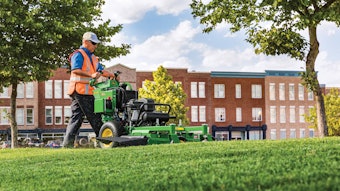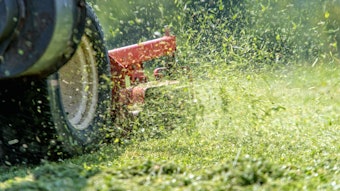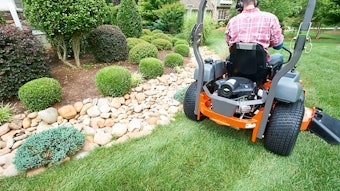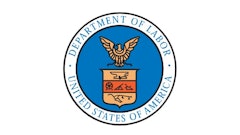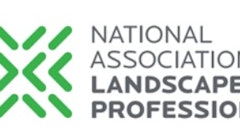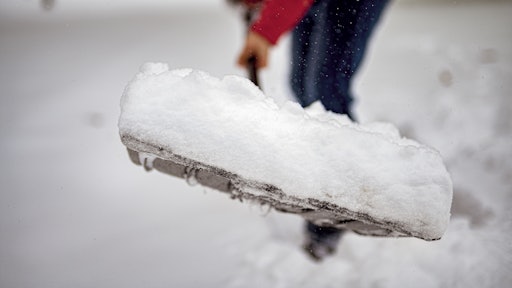
Many snow and ice management professionals would argue that snow removal is not their primary role. As much snow is pushed, the actual role for many snow contractors is risk management.
Offering snow and ice removal services can be a lucrative business proposition during the winter, especially in regions that see frozen weather for a significant portion of the year. One of the challenges of being a snow and ice removal contractor relates to the potential slip and fall liability.
Slips and falls due to snow or ice is a common cause for injury during cold weather months. Not only does the snow or ice cause your feet to slide out from under you in unpredictable ways, but the frozen surface is also usually rock hard and incredibly unforgiving to any part of the body that hits the ground.
Whether it’s a broken arm, a sprained ankle, a knock to the head or just severe bruising, injuries from slips and falls often require medical attention.
Who is responsible?
Generally, for a slip and fall claim, responsibility is going to depend on the contract that was signed.
“Theoretically, it depends on when and where the incident occurred. However, when a claim is filed, they are going to bring all parties into the lawsuit,” Accredited Snow Contractors Association Executive Director Kevin Gilbride says. This means the property owner, the property manager, and the snow contractor. If any subcontractors are involved, they are often included in the suit as well.
“The contract should have a clause that spells out who is responsible for what in the claims,” Gilbride says. “To often, the snow contractor is signing a contract that places all of the liability on them, often without reading the contract.”
It has nearly become an industry practice for most snow and ice removal contracts to hold the contractor, not the property owner or client, responsible for any slip and fall claims.
Within the industry, slip and fall claims are causing insurance premiums to continually rise and over the past several years more insurance carriers are dropping casualty insurance, specifically snow coverage.
A few years ago, the state of New Jersey was down to having only three insurance carriers that offered any type of coverage for snow contractors. Other states faced similar challenges because insurance companies got out of the snow business when it was not profitable for them.
From an insurance perspective, there are 30,000+ slip and fall claims annually in the United States and Canada that are filed against snow and ice management companies, property owners and management companies.
Determining liability in slip and fall claims includes factoring in a state’s use of the natural accumulation rule. In many states where it becomes cold and slippery in winter, for there to be liability for a fall on snow or ice, there must be an unnatural accumulation.
Generally, snow and ice are considered natural accumulation if it is the result of natural weather conditions. In essence, if you live in a climate where snow and ice accumulate, so watch your step. While it varies from state to state, if the snow and/or ice was not shoveled or treated in some way, there is less likely to be liability issues. In addition, snow and ice that is packed down by pedestrian or vehicular traffic can be defined as natural accumulation in some areas.
Property owners who attempt to make an area safer by shoveling or plowing are potentially more at fault than those that do not. Ruts, bumps, and slippery areas formed after salt treatment and refreeze are often labeled as unnatural accumulation. Laws vary by state and down to the municipal level in terms of requirements for property owners to clear sidewalks, entrances and exits of their buildings. Ultimately, it is a matter of legal judgement whether accumulation of snow and ice is artificial or natural.
Some East Coast states still follow some version of the on-going storm rule. Under this scenario, commercial property owners are generally relieved of any obligation to render their property safe from weather while sleet, snow or ice are still falling. Some jurisdictions have altered the rule to add a reasonable care standard, leaving the expectations of the property owner to address slippery snow and ice conditions based on the amount of traffic, risk, and burden of snow removal.
No liability, no quality
When the slip and fall claims are not the responsibility of the client, how is that client going to go about selecting a snow removal service?
“If the client has no liability, his willingness to pay more to get the higher quality contractor goes down,” says Arctic Snow and Ice Control Inc. spokesperson Dave Peters.
If a property owner is offered a lowball seasonal contract from some national snow and ice management company utilizing small local subcontractors, he may find the numbers hard to resist. However, as is most often the case, as soon as the snow comes down heavy enough, the subcontractor disappears rather than lose money, leaving the property manager very few options.
Two of the current scourges of the industry impacting insurance liability and the willingness of carriers to cover the snow industry are the national “snow and ice management” firms and the large property management companies who offer snow removal services along with landscaping, facilities maintenance, etc.
Many in the industry are commenting on the proliferation of large management firms who operate in out of state locations where they have banks of telemarketers but no snow equipment and convince clients to pay them via lowball seasonal contracts knowing that the service provided, if they do sign a subcontractor, will be inadequate or nonexistent. Often the only subcontractors they will attract are the individuals with maybe a few trucks and plows, with clearly no chance of performing to expectations. Since these “management” firms offer so little and hold back payment when the service is not perfect, the small subcontractor will simply abandon the property when the big storm comes in, the time when the clients need it the most. Unfortunately, these companies are typically so large that they appear legitimate, and their goal is to get whatever rate they can on that business.
“When you see the name ‘Snow and Ice Management’ beware,” say Peters. “These are essentially risk management firms who pass all of their slip and fall liability on to their subcontractors via ‘hold harmless’ clauses, which the courts have only started to address. Keep in mind two things. These subcontractors cannot afford nor are granted adequate liability insurance, so that the client is still forced to deal with lawsuits. Second, the attorney lobbies are very strong. The most lucrative source of revenue for attorneys is now slip-and-fall claims, exceeding that from divorces. Do not expect lawyers to sit idly by as you seek to reform the industry.”
Via seasonal contracts, the alleged snow contractors are paid throughout the season whether it snows or not. Peters says the industry refers to this as the “pray for no snow” model.
“When there is any significant winter weather, they will be unable to perform and very possibly fired from that account. However, based on the contract, they were already paid for work that was never done,” he says. “Lowballed bids and poor performance are their standard operating procedure.”
A similar scenario takes place with the large property management firms that provide landscaping and facilities maintenance along with snow removal. “These firms may be a little more naïve about the difficulty of snow removal, but they are also consistent in their greed as far as saving money at the expense of quality and safety,” Peters says.
He suggests that sometimes it is necessary for all parties to get a proper education on snow. “They need to understand that it’s okay to mow a lawn or clean windows on a Thursday rather than a Tuesday, but that does not work with snow,” Peters says. “You must have a different breed of company that is equipped and dedicated to dealing with the tremendous demands of clearing snow and making parking lots and sidewalks safe in all kinds of relentless winter weather.”
He says the future of big box retail is going to be affected by issues like this if the insurance liability issue is not remedied. “It never will be if all parties are not motivated to reduce the actual likelihood of slip and fall events through proper management of their properties,” Peters says. “Otherwise, insurance companies will drop them, or their prices will have to escalate dramatically. In either case, and online shopping will simply take over and they will have to close.”
Current contract language is part of the problem
Typically, snow contractors enter into agreements with big-box stores and lack negotiating leverage. The stores force liability completely onto the contractor without having any incentive to share the problem. Insurance companies also have a strong desire to avoid the courts and find a quick settlement.
“There are two problems here,” say Peters. “First, you have a contract that allows a store to essentially not care if someone slips and falls on their property, because they are strictly concerned about liability. Second, with insurance companies so eager to settle, regardless of true fault, all contractors, from the truly good firms to the truly bad, are lumped in together when it comes to determining insurance premiums or even the availability of insurance.”
To combat this issue, the industry has been trying to get new laws passed to address this.
The Snow Removal Limited Liability or Liability Limitations Act is ASCA’s model legislation that is in the process of being developed in multiple states. Gilbride says the bill would make the hold harmless and indemnification agreements in snow and ice management contracts null and void when the property owner or property management company passes their liability onto the snow and ice management company.
The original purpose of legislative effort was to protect the contractor and put the liability on the client. However, Arctic was one of the companies that argued that it was important to have some liability on the contractor.
"If you put all the burden on the client,” say Peters, “they are still likely going to go out of business. We want to encourage them to use a better supplier, but we also want to encourage that contractor to do a better job.”
Illinois enacted ASCA’s model legislation in 2016, a version of it was approved in Colorado in 2018 and Connecticut signed it into law in July 2019.
There are active efforts in Massachusetts, New York, New Jersey, Michigan, Wisconsin, and Pennsylvania where the law is being reintroduced or introduced. Unfortunately, the pandemic slowed some efforts to get any new laws passed. pandemic stalled efforts to get more laws passed.
“We virtually lost a year due to the other things going on, as everyone is aware of,” Gilbride says. “However, we are back on track in Pennsylvania and Massachusetts and expect to be able to announce some news out of New Jersey and New York soon.”
He encourages contractors to become certified to improve their processes and procedures in their businesses and become more risk averse.
At this point, as ASCA continues its efforts to get the law passed in more and more states, it becomes a matter of educating the clients that the past contracts are no longer valid and that there cannot be paragraphs that removes any liability for any party.
“We're trying to eliminate the number of trips to the court by making parking lots safer, having fewer slip and falls and having big box retailers pay more for their snow service to ensure that they get a better-quality service,” Peters says. “Problems arise when people are looking for the lowest deal.”
Safeguard your livelihood, brand, and finances
If you are a landscaper or another type of contractor who offers snow and ice removal services during the winter, it is important to know how to protect yourself again slip and fall liability. Not only can a slip and fall lawsuit cause you to lose money out of your pocket, it also could cost you your reputation and even threaten to shut down your business.
Following a few basic practices can help you safeguard your livelihood, brand, and finances. Here are five general best practices to follow:
1. Follow the American National Standards Institute (ANSI) industry standards for snow and ice management.
Gilbride explains that the standards detail everything a snow contractor needs to document from training to preseason inspection all the way through in-event and post-event operations.
“It's another quality check,” Peters says. “You want to demonstrate to an auditor that you have a consistent process that you follow property to property.”
In addition, ASCA has worked extensively with the International Organization for Standards Organization (ISO) and Mills Insurance Group to develop the ASCA-C educational program and ISO9001/SN9001 certification. To date, these are the only snow and ice management certifications recognized by the insurance industry.
To date there are dozens of ANSI-certified auditors around the country. Gilbride noted that in the end it is a verification system that insurance carriers and customers can look at and recognize differences.
2. Carry adequate, up-to-date general liability insurance.
In the general contracting and snow removal industries, these polices may be called general liability (GL), commercial general liability (CGL) or snow removal insurance.
Regardless of the insurance policy’s specific name, a general liability insurance policy typically covers bodily injury, property damage and other incidents for which your company may be found liable. In the instance of a slip and fall claim for which you are found liable, your policy would pay the claimant’s medical bills and other associated expenses, thus protecting you from potentially high out-of-pocket costs. Your primary cost would simply be the policy’s deductible.
Speak with a trusted agent to determine the best policy for your needs and budget. While a policy that has a lower deductible and covers a higher amount for each category (bodily injury, property damage, etc.) will cost more per month or year, it will also provide more protection to you in the event of a claim.
Finding the right balance for your business needs and budget is key.
3. Read, understand, and complete your contract
Gilbride says one of the main components of avoiding slip and fall claims is ensuring you read the contract and understand what you are signing. “Contracts where the property owner tries to control the scope of work too much can be very troublesome down the line,” he says.
For example, if the indemnification clause in a contract reads something to the effect of that the snow and ice management company will be responsible for any and all accidents, incidents and injuries on the property as relates to snow and ice, it is not very helpful if the scope of work with a clause like that and the contract reads that the company will not commence plowing until there is two inches on the ground and the property owner will tell you when to salt. In that scenario the contractor is liable if there is one inch on the ground and they are not supposed to do their job.
“If you are not looking and reading at the indemnification clause in your contract before signing it, you could virtually put yourself out of business,” Gilbride says.
A related issue is the hold harmless agreements which determine that because a snow and ice management company is holding the property owner harmless, the company’s insurance company must hire an attorney to defend its client in a lawsuit or claim and another attorney to defend the property manager.
Once a contract is signed and the first step in protecting yourself from slip and fall liability suits or claims is to ensure the job is completed properly. When contracted to remove snow and ice from surfaces, be sure to remove all traces of slippery hazards. For example, after plowing and/or scraping snow and ice away, spread rock salt to melt any remaining frozen debris and to keep any water from refreezing.
If you have been hired to keep the area clear (rather than simply clearing it one time), revisit often to clear any additional snow or ice that falls/freezes.
4. Document all the work you do on a property.
Documentation of snow and ice management work is critical in addressing slip and fall claims and other liabilities. It is nearly impossible to return to the site of a slip and fall incident days after a snow event and be able to observe the exact conditions in which the incident occurred.
With the latest technology, contractors can provide documentation of their service by taking both before and after photos. Many programs allow companies to use geofencing to better identify when crews arrive and depart jobsites.
“At the end of the day, every single court in this world thrives on documentation,” Peters says. “It is your very best friend.”
5. Be transparent with potential clients
Snow can be a very lucrative business. As such, it attracts all kinds of individuals who will prey on the uneducated and unsuspecting client. It is very important to visit the contractors’ facilities if you want to avoid problems later. There are too many examples of individuals promising great service for the winter, but they do not have a documented history or capability of providing that service. Only those firms who have documentation of past purchase/rent of heavy equipment and who own a fleet of pusher/plows should even be considered.
“We know of a high school kid from the Chicago area who put together a brochure on his computer and went out for bids and was granted a few,” says Peters. “He had never been in the snow business. We caught up with one of his ‘new customers’ and pointed out to her that this exciting new Chicago-area business did not exist and that this individual had even photoshopped the Rocky Mountains in the background, which should have been a red flag. When she entered the address on Google Earth, there was nothing there. This is why we advise clients to Google a contractor’s site, not their website.”


